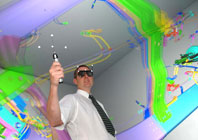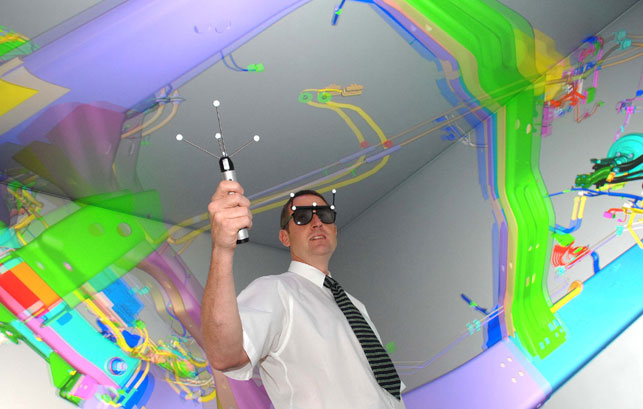Remember the startling scene from the 1980s classic film, Back to the Future II when Michael J. Fox is attacked by a virtual shark that jumps out of a billboard and into the street?
Luckily there is no need to fear sharks in our towns quite yet, but according to HoloVis International, the UK visualisation specialist, it is only a question of months before the first prototypes for a live billboard will be ready to make their mark in the cityscape.

“Large-scale Autostereo 3D is just around the corner. By mid 2010, we expect to have the first large-scale screens and multi-screen solutions that will create 3D without the use of glasses,” says Stuart Hetherington, managing director at HoloVis. Together with his team and key technology partners, Hetherington is working intensely to realise the dream of “true 3D for all” – and the goal is now within reach.
Autostereo 3D is the technology that makes it possible to experience 3D without glasses – on both TV/computer screens and with projectors.
While immersive and interactive 3D solutions, based on the use of special glasses, is also a key technology from HoloVis and has widespread use in industries from automotive design and manufacturing to cinemas and amusement parks, Autostereo 3D brings the same impressive experience to the wider audience, including public spaces such as airports. This opens up a world of possibilities to utilise the technology, and Hetherington expects strong demand.
“We believe sales of this new technology will be excellent because it opens much broader areas for the utilisation of 3D, such as advertising, POS and live events,” he says. “Our close collaboration with Autodesk also allows us to make use of their broad range of design tools to reach many different industries that have significant and often untapped potential to visualise, simulate and analyse 3D design solutions in our mainstream 3D virtual reality environments.”
Automotive sector shows the way
Hetherington’s pioneering technological work has always been closely associated with the automotive industry. He helped innovate a virtual alternative to physical crash tests back in the mid 1990s for MIRA (The Motor Industry Research Association based in the UK.) It was this work that originally introduced him to “the cave automatic virtual environment”, or CAVE, which General Motors was one of the first to use. CAVE solutions combine the most sophisticated design software, computing systems and 3D display technology to build an immersive 3D virtual reality environment in which designers and engineers can conceive, experience, collaborate and modify their creations in real-time.

Digital mockup of a Land Rover using a CAVE
A CAVE is a small room in which several walls and sometimes the floor and ceiling are large rear-projection screens; using interactive 3D glasses and motion tracking systems, those in “the cave” can view, interact and navigate around prototypes almost as if they were the real thing.
Inspired by his experience in the UK and US automotive industries, Hetherington founded HoloVis International in the UK in 2001 along with his former MIRA manager, Joe Jurado, as his technical director and expert in projection design solutions and his brother Paul, an expert in super computer systems and software. Then as now, the company was driven by its passion to explore the potential of visualisation technologies and continually to push the envelope on virtual reality. The automotive industry is still in front when it comes to adapting next-generation CAVE solutions from HoloVis, but new markets and new applications continue to adopt the technology as it develops. This is especially true for HoloVis’s other key area of business “Specialist Display Solutions”.
“We work in two main business areas,” explains Hetherington. “One is virtual reality and visualisation technology, the other is specialist display solutions where we create bespoke multi-channel display solutions capable of displaying real-time imagery way beyond the current HD standard. We have recently delivered several of our specialist JupiterWall multi-screen display solutions to the World Duty Free stores in Terminal 5 at Heathrow Airport and are now rolling these out to many other airports in close partnership with WDF/Autogrill. Our next milestone will be to bring these multi-screen solutions to life by bringing true immersive 3D effects to audiences in public spaces, without the need for glasses.”
Broad penetration
Within the business area of virtual reality and visualisation, HoloVis completed a project for Cardiff University early last year that entailed constructing a screen to simulate an MRI scanner.
The Welsh university uses the system to teach students how to use these scanners, but as they are extremely costly, the university decided to replace the physical scanner with a virtual simulation for effective teaching purposes. The result was that they chose one of the ultra-high resolution (4K) ApolloWall systems from HoloVis that visualises the MRI scanner in a 1:1 format and utilises the same physical control unit as the rear-world scanning systems. The most advanced solution of its kind in Europe, the ApolloWall now plays an active role in teaching and research at Cardiff University.
In addition to universities, new HoloVis customers include airport terminals, cinemas, architectural and manufacturing firms. Among other things, business development at HoloVis is driven by the firm’s close cooperation with Autodesk, whose CAD tools are used in many industries.
“For example, if an architectural firm gives us a 3D model of a building created in Autodesk Revit we can facilitate a virtual walk through of the building in our ApolloWall or CAVE demo systems; this makes it possible for stakeholders to experience the building long before final designs are approved or construction has even begun. This experience obviously beats looking at even the most expensive papier maché models of the same building and not only saves huge costs for physical modelling but vast amounts of time and labour.”
Efficiency gains
That HoloVis solutions are here to stay is made even clearer by the company’s performance in the current financial crisis: demand for our advanced visualisation systems has risen, not fallen. HoloVis delivered a €3m CAVE project to Jaguar Land Rover in 2008 that is equipped with eight of Sony’s latest 4K projectors.
The new CAVE delivers imagery that is sharper than anything ever before seen and is a true photorealistic immersive environment. Combined with design tools such as Autodesk Showcase, the CAVE gives Jaguar Land Rover designers and engineers an immersive workshop that obviates the need for many physical prototypes and improves collaboration between engineering and design teams. The results? Within a year, Jaguar Land Rover has achieved efficiencies worth millions – solely due to the CAVE solution and the integration with key software.
Hetherington is also upbeat about the future. “Today we are creating the solutions that we dreamt about 10-12 years ago,” he says. “It’s fantastic to see how the technology is gaining recognition and its use is spreading rapidly. In the past we used to be told by our peers that this technology was a ‘solution looking for a problem’ – the technology, capability and savings these problem-beating solutions now deliver to all our clients speaks for itself – there’s no doubt that we will see many more achievements as we continue to develop this key technology.”
www.holovis.com 
Immersive environments are sharpening up virtual reality, bringing 3D without the glasses






